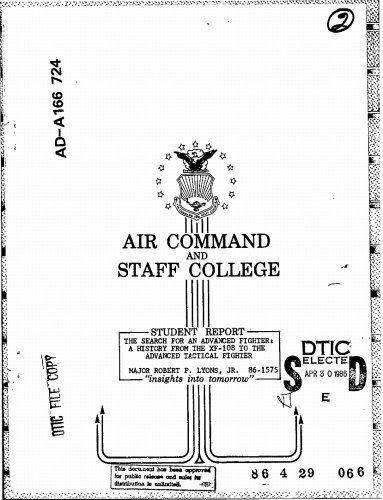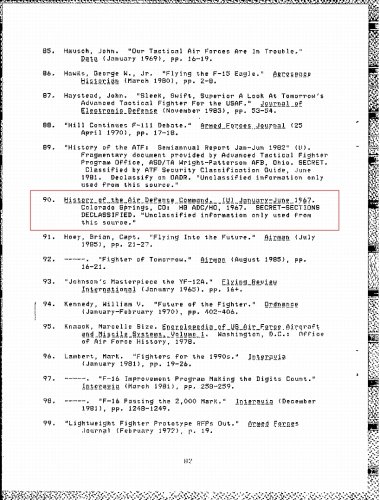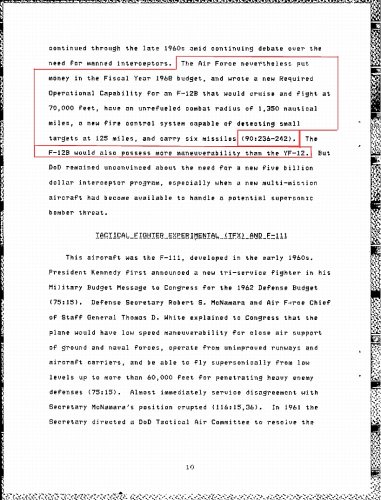This document has already been referenced in this forum, but I will include the link anyway because it is a very concise summary of the Air Force's search for a truly new advanced fighter:
Lyons, Major Robert P. Jr. (3 April 1986)
"The Search for an Advanced Fighter: A History from the XF-108 to the Advanced Tactical Fighter"
http://www.dtic.mil/cgi-bin/GetTRDoc?Location=U2&doc=GetTRDoc.pdf&AD=ADA166724

Page 10 of this report talks about the Air Force's new ROC (Required Operational Capability) for the F-12B in the FY1968 Air Force budget (not the DOD budget):
- Cruise and fight at 70,000 feet -- (YF-12A = 80,000 feet @ Mach 3.35, no problem).
- Unrefueled combat radius of 1,350 nm (1,554 miles) -- (YF-12A = 1,500 miles, no problem).
- A new fire control system detecting "small targets" at 125 miles -- (YF-12A = 100 miles, in the works).
- Increased armament to SIX Air-to-Air Missiles!!! -- (no need for a 20mm cannon, but a longer fuselage maybe?).
- More maneuverability than the YF-12A prototype!!! -- (big problem!!!).

The source of this summary are pages 236-242 of "History of the Air Defense Command January-June 1967"

Two points of interest to me are the additional AAMs and maneuverability requirements.
Adding two more weapons bays in the fuselage chines may not have been too big of a deal, but the need to be more maneuverable surely would have required additional strengthening and an increase in the wing area.
The original XF-108 Rapier design that was cancelled in favor of the YF-12A had a wing area of 1,865 square feet while the YF-12A was 1,795 square feet. The Rapier's engines were mounted inside the fuselage while the YF-12A's engine were mounted in mid-wing nacelles. Hard turns with mid-wing engines would surely have increased the stresses on the wing spars.
Sharp turns while flying ANY of the Blackbirds was explicitedly discouraged. The one time that a SR-71A made a sharp turn at altitude and speed resulted in the complete "disintegration" of the aircraft! (note: On January 25, 1966, test aircraft #61-7952 was making a 30 degree right bank at Mach 3.1 and 80,000 feet. The pilot survived, the test engineer did not).
Also, what about the under-tail folding fin? That was added to increase directional stability, not to make the YF-12A more maneuverable. On February 27, 1975, NASA discovered that the folding fin was not really needed (NASA FLT 090, YF-12A #935: The main ventral fin separated during a sideslip maneuver at Mach 3.0).
The added weight of the strengthening modifications may have required more powerful J58 engines. Pratt & Whitney was working on a "thrust enhancement" program for the J58's during the SR-71 period. If the Air Force had TWO Mach 3 aircraft with J58's (SR-71 and F-12B), would replacing the entire Lockheed fleet's engines have been a given?
So, with all of this new ROC stuff, would there have been the need for an additional prototype? A YF-12B for example, leading to a new production version, the F-12C? Also, the Air Force had two SR-71B trainers. Would the Air Force spring for some "F-12T or F-12D" trainers as well? Just wondering...
If anyone can find this source document (History of the Air Defense command, January-June 1967), it would probably help in clearing up this little mystery.
Lyons, Major Robert P. Jr. (3 April 1986)
"The Search for an Advanced Fighter: A History from the XF-108 to the Advanced Tactical Fighter"
http://www.dtic.mil/cgi-bin/GetTRDoc?Location=U2&doc=GetTRDoc.pdf&AD=ADA166724

Page 10 of this report talks about the Air Force's new ROC (Required Operational Capability) for the F-12B in the FY1968 Air Force budget (not the DOD budget):
- Cruise and fight at 70,000 feet -- (YF-12A = 80,000 feet @ Mach 3.35, no problem).
- Unrefueled combat radius of 1,350 nm (1,554 miles) -- (YF-12A = 1,500 miles, no problem).
- A new fire control system detecting "small targets" at 125 miles -- (YF-12A = 100 miles, in the works).
- Increased armament to SIX Air-to-Air Missiles!!! -- (no need for a 20mm cannon, but a longer fuselage maybe?).
- More maneuverability than the YF-12A prototype!!! -- (big problem!!!).

The source of this summary are pages 236-242 of "History of the Air Defense Command January-June 1967"

Two points of interest to me are the additional AAMs and maneuverability requirements.
Adding two more weapons bays in the fuselage chines may not have been too big of a deal, but the need to be more maneuverable surely would have required additional strengthening and an increase in the wing area.
The original XF-108 Rapier design that was cancelled in favor of the YF-12A had a wing area of 1,865 square feet while the YF-12A was 1,795 square feet. The Rapier's engines were mounted inside the fuselage while the YF-12A's engine were mounted in mid-wing nacelles. Hard turns with mid-wing engines would surely have increased the stresses on the wing spars.
Sharp turns while flying ANY of the Blackbirds was explicitedly discouraged. The one time that a SR-71A made a sharp turn at altitude and speed resulted in the complete "disintegration" of the aircraft! (note: On January 25, 1966, test aircraft #61-7952 was making a 30 degree right bank at Mach 3.1 and 80,000 feet. The pilot survived, the test engineer did not).
Also, what about the under-tail folding fin? That was added to increase directional stability, not to make the YF-12A more maneuverable. On February 27, 1975, NASA discovered that the folding fin was not really needed (NASA FLT 090, YF-12A #935: The main ventral fin separated during a sideslip maneuver at Mach 3.0).
The added weight of the strengthening modifications may have required more powerful J58 engines. Pratt & Whitney was working on a "thrust enhancement" program for the J58's during the SR-71 period. If the Air Force had TWO Mach 3 aircraft with J58's (SR-71 and F-12B), would replacing the entire Lockheed fleet's engines have been a given?
So, with all of this new ROC stuff, would there have been the need for an additional prototype? A YF-12B for example, leading to a new production version, the F-12C? Also, the Air Force had two SR-71B trainers. Would the Air Force spring for some "F-12T or F-12D" trainers as well? Just wondering...
If anyone can find this source document (History of the Air Defense command, January-June 1967), it would probably help in clearing up this little mystery.



